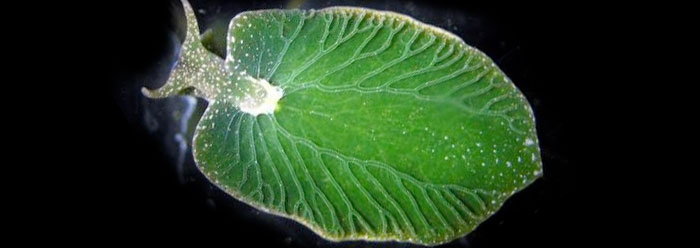 Did
Sea Slugs Evolve to Steal Genes? By Jeffrey Tomkins, Ph.D. *
Did
Sea Slugs Evolve to Steal Genes? By Jeffrey Tomkins, Ph.D. *
Solar-powered sea slugs (sacoglossan molluscs) feed on filamentous algae, a water plant, to capture photosynthetic organelles called chloroplasts and use them for solar energy. Considered kleptoplastic because they "steal" from another organism, sea slugs have been suspected of using horizontal gene transfer (HGT) to accomplish this, a find that many scientists believe would support evolution.
To keep the stolen chloroplasts alive and well inside the cells of their pervasive digestive tracts for several months at a time, sea slugs need the help of algal genes that code for important chloroplast maintenance proteins. Scientists first thought that these "algal genes" were stolen and integrated into the genome of the sea slug through HGT. In other words, they believed that at some point during the slug's evolution, it had somehow stolen just the right algae genes needed to make the stolen chloroplasts function.
Initial research seemed to show the presence of algal DNA in the slug genome, although the data was often conflicting and inconclusive.1 The problem was that scientists always used slug tissue to extract DNA that contained algal contamination.
In a new study, scientists extracted uncontaminated DNA from kleptoplastic sea slug eggs that had never come in contact with algae. After an exhaustive DNA sequencing process, the scientists concluded that the slugs and algae did not share any genes, and therefore the slugs had not acquired any algal genes through HGT.2
Some scientists believe that for evolution to be feasible, HGT has to have occurred on a grand scale among complex multicellular organisms like the solar-powered sea slug. In fact, the pervasive phenomena of large numbers of specific genes found in some organisms and not others (orphan genes) is believed to be explained by HGT. As this most recent sea slug study shows, these ideas have yet to be proven.3, 4
With the evolutionary explanation of HGT now shown to be completely lacking, what actually seems to be going on here? The scientists also tested adult sea slugs and found algal DNA in their system that encoded the genes necessary to make the chloroplasts work, and they concluded that the genes resided on extra chromosomal circular DNAs (eccDNAs). Surprisingly, eccDNAs are spliced out of a creature's genome, such as the algae, and formed into stable circles. In fact, eccDNAs of different types are found across the spectrum of life—even in humans!5
Could it be that the Creator designed the algae to not only provide chloroplasts for the sea slugs but also for the algal eccDNAs that contain the genes to make the whole living system work? In this scenario, both the chloroplasts and the eccDNAs would be extracted from the algae at the same time, and new genomics data indicates that this is likely the case. The sea slug is not an evolved kleptomaniac at all but a wonderfully engineered system co-designed with the algae.
References
- Pierce, S. K. et al. 2012. Transcriptomic evidence for the Expression of Horizontally Transferred Algal Nuclear Genes in the Photosynthetic Sea Slug, Elysia chlorotica. Molecular Biology and Evolution. 29 (6): 1545-1556.
- Bhattacharya, D. et al. 2013. Genome Analysis of Elysia chlorotica Egg DNA Provides No Evidence for Horizontal Gene Transfer into the Germ Line of this Kleptoplastic Mollusc. Molecular Biology and Evolution. 30 (8): 1843-1852.
- Tomkins, J. 2013. Newly Discovered 'Orphan Genes' Defy Evolution. Creation Science Update. Posted on icr.org August 26, 2013, accessed October 25, 2013.
- Tomkins, J. 2012. Are Rotifers Gene Stealers or Uniquely Engineered? Creation Science Update. Posted on icr.org December 3, 2012, accessed October 25, 2013.
- Shibata, Y. et al. 2012. Extrachromosomal MicroDNAs and Chromosomal Microdeletions in Normal Tissues. Science. 336 (6077): 82-86.
Image credit: Copyright © 2013 EOL Learning and Education Group. Adapted for use in accordance with federal copyright (fair use doctrine) law. Usage by ICR does not imply endorsement of copyright holders.
* Dr. Tomkins is Research Associate at the Institute for Creation Research and received his Ph.D. in genetics from Clemson University.
Article posted on November 6, 2013.